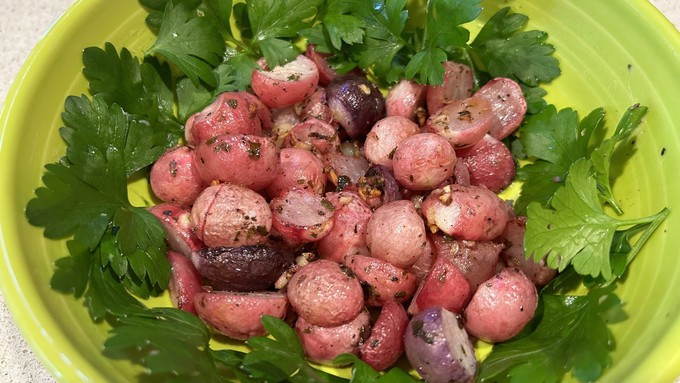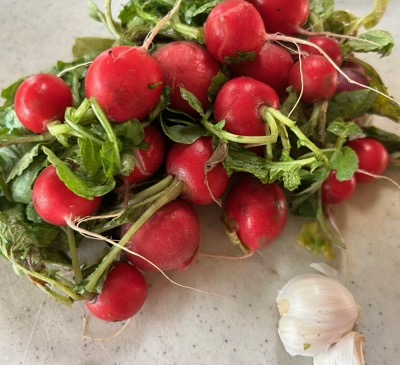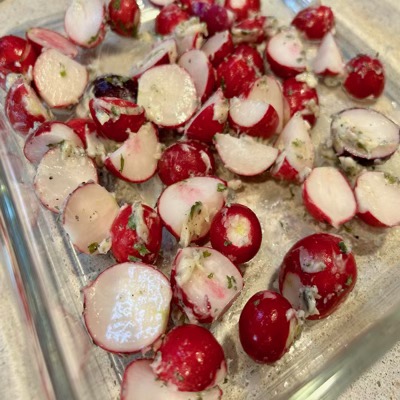
Recipe: Roast these little root veggies with garlic

Roasted radishes with garlic make a great side dish with grilled meats or other vegetables. Kathy Morrison

The cute little spring radishes, including the red/pink/purple/white combo dubbed "Easter egg radishes," still have a bite if eaten raw. But apply some heat to those quick-growing root vegetables via roasting and they turn delightfully mellow.
This recipe is super-easy and can be used with any type of radish. Add some minced garlic during roasting and the result is a flavorful side dish to grilled meats or other grilled vegetables (such as portobello mushrooms).
The roasted radishes also can be enjoyed at room temperature as part of a salad -- ranch dressing goes particularly well with them.
Add as much garlic as you like but wait until the latter part of the cooking time so it doesn't overcook and become bitter. (Not a garlic fan? Chopped spring onions are another option.) The herbs are variable -- whatever fresh one you have much of will work, or used your favorite dried herb.
Garlic-roasted spring radishes
Serves 2 to 4
Ingredients:
1 tablespoon melted butter or flavorful vegetable oil such as avocado oil
Two to three bunches small radishes, at least 8 ounces total and up to 1 pound, washed
1/2 teaspoon kosher salt
Freshly ground pepper to taste
1/2 teaspoon dried herbs, such as parsley or oregano, or 1 tablespoon fresh herbs such as basil, chives or parsley
1 to 3 garlic cloves, minced
Instructions:

Heat oven to 425 degrees F. Remove the stems from the radishes and trim off the roots. Halve any larger radishes so that most of the vegetables are the same size.
In a bowl, combine the butter or oil, the trimmed radishes, the salt, pepper to taste, and the chosen herbs. Toss to coat the radishes evenly.
Scrape the radish mixture into a baking dish, spreading the radishes in an even layer.
Bake for 12 minutes, then stir the vegetables, add the minced garlic to the dish, and stir again.
Continue roasting until the radishes are crisp-tender, 8-12 minutes. Watch that the garlic doesn't burn.
Serve immediately or allow to cool to room temperature if adding to a salad.
Comments
0 comments have been posted.Sacramento Digs Gardening to your inbox.
Sites We Like
Garden Checklist for week of July 21
Your garden needs you!
* Keep your vegetable garden watered, mulched and weeded. Water before 8 a.m. to reduce the chance of fungal infection and to conserve moisture.
* Feed vegetable plants bone meal, rock phosphate or other fertilizers high in phosphate to stimulate more blooms and fruiting. (But wait until daily high temperatures drop out of the 100s.)
* Don’t let tomatoes wilt or dry out completely. Give tomatoes a deep watering two to three times a week.
* Harvest vegetables promptly to encourage plants to produce more. Squash especially tends to grow rapidly in hot weather. Keep an eye on zucchini.
* Pinch back chrysanthemums for bushy plants and more flowers in September.
* Remove spent flowers from roses, daylilies and other bloomers as they finish flowering.
* Pinch off blooms from basil so the plant will grow more leaves.
* Cut back lavender after flowering to promote a second bloom.
* It's not too late to add a splash of color. Plant petunias, snapdragons, zinnias and marigolds.
* From seed, plant corn, pumpkins, radishes, winter squash and sunflowers.